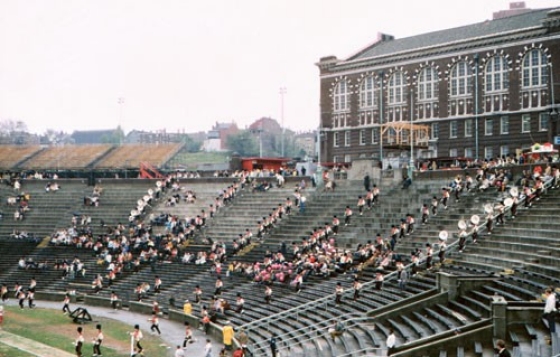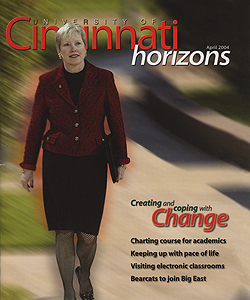Traditions of the UC Bearcat marching band

In 1954, University of Cincinnati Bearcat marching-band morale was low, and respect from the student body even lower. To attract attention and spark enthusiasm, new band director Bob Hornyak decided the band should make a spectacular grand entrance at the next football game.
Right before kickoff, brass and woodwind sections lined up behind the top row of seats at Nippert Stadium's closed end. After playing a fanfare, the students charged down the steps with instruments in hand to meet the percussion section waiting below.
The crowd went wild. The band members beamed. Later, letters of praise started coming in from appreciative fans.
"Fans"? That was a new concept for the band. The move was certainly worth trying a few more times.
Fifty years later, the Marching Bearcat Band's method of storming the field at football games celebrates its golden anniversary. "We wanted to make a splash, a statement that we were different," recalls Hornyak, now music professor emeritus. "And we did."
When current band director Terren Frenz arrived in '94, he cringed when he heard about the practice. "It scared me. I thought, 'OK, call my lawyer; this is a nightmare waiting to happen.'"
But he quickly realized that eliminating the maneuver was not a decision in his realm of authority. "If I tried to destroy that, I'd be hung in effigy," he says with a laugh. "It's considered a risk of honor."
Although Frenz did make the run optional, he has no horror stories to relate. "The worst problem we have had is keeping the fans out of the way," he says. "We mow them down."
During Hornyak's 16-year career as band director, he never let the band rehearse the stunt before the season began. If students spent too much time worrying about the routine, he says, they might have psyched themselves into falling. "And we made the rule that if anyone fell, you had to roll them out of the way so they wouldn't interfere with the next person," he says with such a slight grin that he might be serious.
Only one student tripped during his tenure. Nevertheless, psyching students into trembling over the tactic was a chore upperclassman relished. "We always wanted to scare the freshmen to death," says alto-sax and clarinet player Linda Gall, Ed '65, MEd '70, also a Band Alumni Association board member. "We made up horrible stories."
"Telling wild tales about people who almost broke their neck was the way upperclassmen hazed the freshmen," Hornyak says. "It was a rite of passage."
Just once did he consider discontinuing the spectacle -- on a snowy Thanksgiving day in the late '50s when he feared charging down 60 icy steps would be dangerous. As he reached the stadium, however, he found senior band members there first, salting the stairs.
"By that time, it had already become a tradition as far as they were concerned," he says. "It was a source of pride. Once you did it, you were part of the group."

For 50 years, the Marching Bearcats have taken the field before a football game by charging down the steps, carrying their instruments. This photo was snapped at homecoming '69 by Beth Rosenberg Kauffman, Ed '72, now a high-school child-development teacher in Maryland.
A strong sense of camaraderie among marching band members has probably been a factor in the band's cultivation of several traditions:
- When the Bearcats win a game, band members turn their hats backward after the game to play "Cheer Cincinnati."
- Afterward, they straighten their hats respectfully to play the "Alma Mater."
- The "hat ripple" occurs after pre-game and half-time performances. Band members stand at attention at their stadium seats until signaled to sit simultaneously, then the drum majors motion for musicians at the end of each row to take off their hats, followed in rapid succession by each member down the line, creating a race between the rows.
- For good luck, band members rap each other on the chest with their knuckles before each performance.
Despite all the traditions, much has changed in the band -- most notably, the addition of women after World War II. "1943 was the first year women played in the band," remembers Nancy Van Wye Lodwick, A&S '44. "We didn't have football that year because of the war, so band director Merrill Van Pelt decided to have a concert band instead of a marching band.
"Most of the band members were GIs with the Army Specialized Training Program (enlisted soldiers being trained on campus). Since I had been a majorette who wasn't going to be able to march, Van Pelt asked me to play flute in the band."
More women were admitted the next year, and in '45, the band returned to the football field, women marching side by side with the men for the first time. As numerous veterans returned to campus in '46, however, many of them expected the band to revert to its all male status. The fall season was a trying time, but the band remained coed.
Experiencing pivotal times in the band as the result of a war seems to be a tradition of its own for the Van Wyes. Nancy's father Ralph Van Wye, Eng '24, formed the band in 1920, after playing for two years in one of the famed Army bands that Gen. John J. Pershing created during World War I.
Following his tour of duty, Van Wye entered UC's College of Engineering, where the commanding officer for the Student Army Training Corp (affiliated with the college at the time) quickly recruited the experienced bandsman to direct a new band he wanted to develop. Helping nudge Van Wye's agreement was the fact that the project fulfilled a college requirement.
Engineering dean Herman Schneider, famous for inventing cooperative education, mandated that his students have a daily "hobby hour" for activities unrelated to their majors. "It was to make you a well-rounded person," UC archivist Kevin Grace, MA (A&S) '77, explains. "Schneider was decades ahead of his time."
The SATC band became Van Wye's hobby hour, as it did for many engineering students. Growth was slow, and the first rehearsal barely attracted eight men. Van Wye often joked that "the only letter we could form was the letter I."
For years, the band remained under the engineering college. But by the time director Bob Hornyak arrived in '54, it was a required course for music education majors and fell under the College-Conservatory of Music. In 1994, when Terren Frenz took the reins, it had migrated to the athletic department. It now stands as an independent department under Division of Student Affairs, although students still get one CCM credit hour per quarter for participating.
"It's a high-demand activity," Frenz says. "We do more than 100 performances a year. There's a constant demand."
When Frenz took over, the band had dwindled to 95 students. Today, it's up to 230 musicians, making it the largest student organization on campus.
Band members can perform in a variety of settings: the marching band, which plays for football games; several pep bands, broken into various sizes to accommodate 40 basketball games; two concert bands; two jazz bands; a winter percussion ensemble; and a competition winter color guard. Frenz also oversees the Alumni Band and a Summer Community Band, started by band alumni two years ago.
It's an ambitious schedule, but Frenz expects a lot from his students. "We get the smartest kids out of the high schools," he says. "The band kids are the ones who are going to achieve, the ones who are going to be successful."
That attitude is evident in the band's high retention rate at UC. "We keep 'em in school," Frenz says. "Band has about a 90 percent grad rate, compared to the national average of less than 40."
Contributing to that envious statistic is the support system that band students have fostered, coaching each other in choosing majors, selecting classes and learning the ropes. "They study together," the director says. "They mentor each other. They take care of each other. It's a giant family."
One large enough these days to spell all the letters in the word "family," too.
Related article:
Links:

 Past Issues
Past Issues